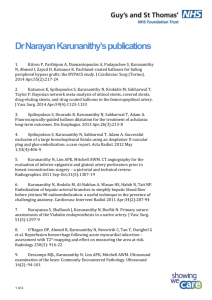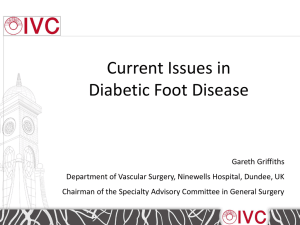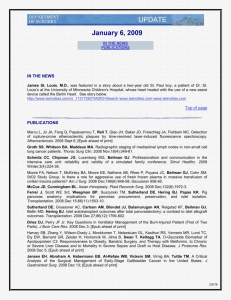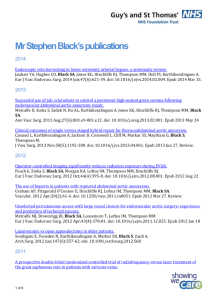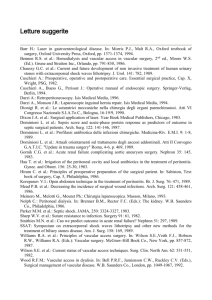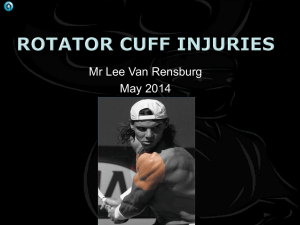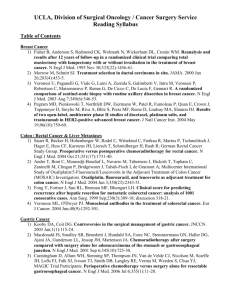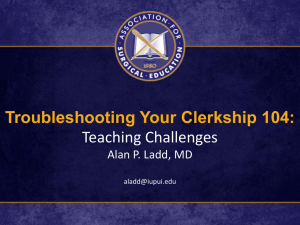1 - BioMed Central
advertisement
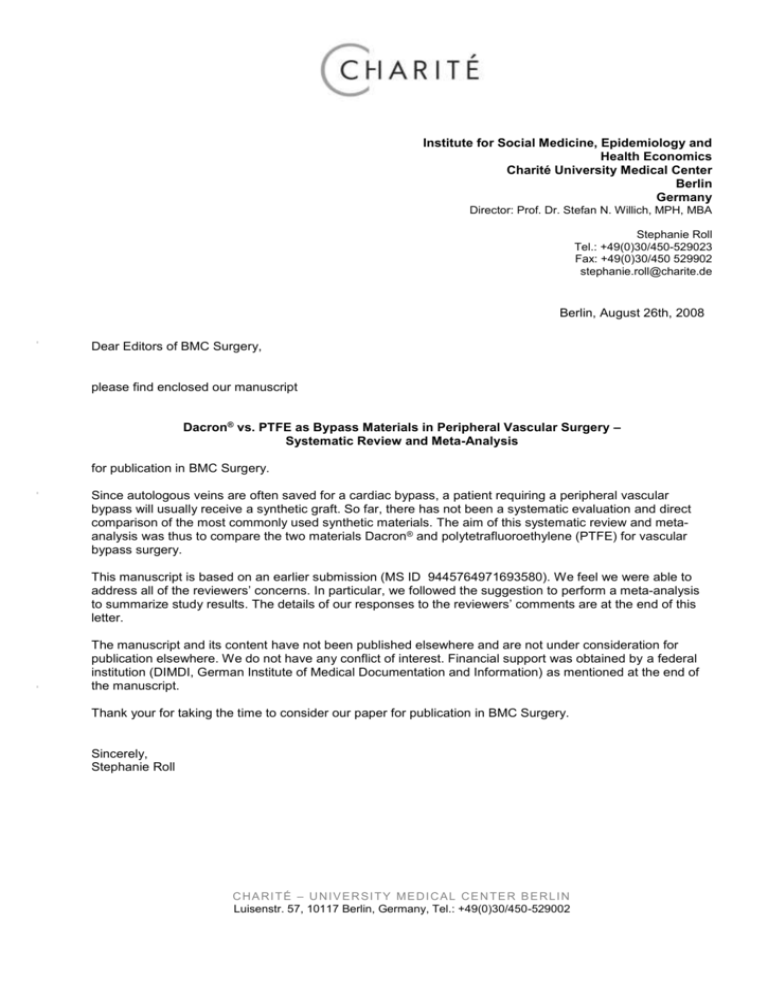
Institute for Social Medicine, Epidemiology and Health Economics Charité University Medical Center Berlin Germany Director: Prof. Dr. Stefan N. Willich, MPH, MBA Stephanie Roll Tel.: +49(0)30/450-529023 Fax: +49(0)30/450 529902 stephanie.roll@charite.de Berlin, August 26th, 2008 Dear Editors of BMC Surgery, please find enclosed our manuscript Dacron® vs. PTFE as Bypass Materials in Peripheral Vascular Surgery – Systematic Review and Meta-Analysis for publication in BMC Surgery. Since autologous veins are often saved for a cardiac bypass, a patient requiring a peripheral vascular bypass will usually receive a synthetic graft. So far, there has not been a systematic evaluation and direct comparison of the most commonly used synthetic materials. The aim of this systematic review and metaanalysis was thus to compare the two materials Dacron® and polytetrafluoroethylene (PTFE) for vascular bypass surgery. This manuscript is based on an earlier submission (MS ID 9445764971693580). We feel we were able to address all of the reviewers’ concerns. In particular, we followed the suggestion to perform a meta-analysis to summarize study results. The details of our responses to the reviewers’ comments are at the end of this letter. The manuscript and its content have not been published elsewhere and are not under consideration for publication elsewhere. We do not have any conflict of interest. Financial support was obtained by a federal institution (DIMDI, German Institute of Medical Documentation and Information) as mentioned at the end of the manuscript. Thank your for taking the time to consider our paper for publication in BMC Surgery. Sincerely, Stephanie Roll C H A R I T É – U N I V E R S I T Y ME D I C A L C E N TE R B E R L I N Luisenstr. 57, 10117 Berlin, Germany, Tel.: +49(0)30/450-529002 Reply to Reviewer Comments 1) Reviewer: Hisato Takagi The authors did not include several eligible randomized controlled trials: J Vasc Surg 1986;3:104-14, Surgery 1999;126:594-602, J Vasc Surg 2000;32:268-77, J Vasc Surg 2000;32:273-83, and Eur J Vasc Endovasc Surg 2007;34:44-9, etc. If they do exclude these trials, they should state the reasons. The Reviewer gives examples of 5 trials that were allegedly eligible, but not included in our review. Two of these trials did not meet our predefined inclusion criteria as described in the methods section of the manuscript: - J Vasc Surg 1986;3:104-14 was published before the time frame of our review, which was focussing on recent trials (literature search period: Jan 1999 to Aug 2008). - Surgery 1999;126:594-602 was not an RCT, and, therefore, excluded because we wanted to include only trials of the highest evidence level. One trial is now included after an updated literature search in Aug 2008: - Eur J Vasc Endovasc Surg 2007;34:44-9 Some misunderstanding must have occurred about the other two trials mentioned: - J Vasc Surg 2000;32:268-77 was included in our review (Reference number 5). - J Vasc Surg 2000;32:273-83 was a publication on an interim analysis of an ongoing trial (J Vasc Surg 2003;37:149-55). It contains 2-years results of a 5-year trial. It does not present any further information, not shown in the main publication after 5 years. The latter had been included in our review. Thus, J Vasc Surg 2000;32:273-83 was not included in our manuscript, avoiding duplicate presentation of trial results. They should also site similar meta-analyses or systematic reviews (of randomized controlled trials): Eur J Vasc Endovasc Surg 2004;27:357-62, J Vasc Surg 2006;44:510-7, and J Vasc Surg 2007;46:612, etc, and discuss what is different between them and their article. We thank the reviewer for this comment and added this aspect in the discussion section. -2- 2) Reviewer: thanos athanasiou 1. Why did the authors not mention the results of previous reviews and meta-analyses on the topic? We thank the reviewer for this comment and added this aspect in the discussion section. 2. What new does this study add to the literature? The aim of our review was to compare synthetic materials available for peripheral vascular bypass surgery. It focuses on the direct comparison of the two most commonly used synthetic materials (polytetrafluoroethylene (PTFE) and Dacron®). Previous reviews in the field were mainly restricted to the comparison of the effects of autologous vein versus a synthetic material (usually PTFE), thus not addressing the question on the preference of synthetic materials when the saphenous vein is unavailable or kept for future bypass procedures. 3. Why did the authors not use meta-analytical methodology to quantify the effect of different grafts on patency rates? Has the study been performed according to the guidelines for reporting systematic reviews /meta-analyses, for example where is the diagram of search strategy and article inclusion-exclusion? We thank the reviewer for this valuable comment and performed a meta-analysis on primary and secondary patency of the available data. The literature search strategy and article inclusion-exclusion are mentioned in the text (see methods and beginning of results section). We now added a flow chart providing results of the in- and exclusion of publications. 5. Have the authors used a validated tool to assess study quality and if yes which components were assessed? Yes, we used standardized checklists to assess the quality of all studies, as mentioned in the methods section. These checklists include components on the description of inclusion criteria of the study participants, the method of randomisation, the description of the intervention(s), the assessment of outcome (valid, reliable, possibly blinded, identical if a multicentre trial), the comparability of study groups at baseline, drop out and response rates, the presentation of reasons for drop out, the appropriateness of statistical analysis methods and the presentation of measures of variability. 6. Why did the authors focus only on English and German articles? We focused on publications of English language, as we feel to cover the most important and qualitatively higher trials therewith. We additionally searched for articles in German for a potential adaption to the situation in Germany. No articles published in German met the inclusion criteria, though. 7. Why did the authors focus only in studies published after 1999? A previously published review covered studies from 1981 to 2000 (Eur J Vasc Endovasc Surg 2004;27:357-62), and J Vasc Surg 2006;44:510-7 included trials from 1986 up to 1997. While the purpose of our review was to provide an overview focussing on the present evidence from more recent trials. -3-
